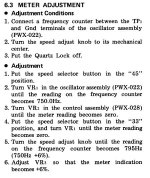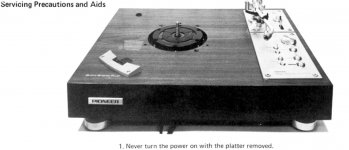I have opened up on my bench a circa 1978 Pioneer PL-560 turntable. Here are the key details:
1. This has a direct drive motor. In at least one Pioneer service bulletin I found, there is a strong warning not to power on the motor without the platter installed.
2. This table does not have a dedicated "On" or "Power" switch. The only way that the various boards inside see any juice is when the "Start" button is pressed. This also starts the motor.
3. All of the boards and most of the adjustment pots are only accessible through the top of the plinth (see photo), which, of course, is blocked by the platter. . . . The bottom is not removable--it's what everything is mounted to.
My conundrum: How do I check voltages on the boards or carry out adjustments that require access to the pots (see attached example) if the table only sees power when Start is pressed, which can only happen with the platter on?
In theory, I need to isolate the switch for the motor itself and disable just that before pressing Start. (This assumes that the power for the rest of the table doesn't also feed through that same switch.) But if that were the case, you'd kinda think the Service Manual would mention something about that important detail.
1. This has a direct drive motor. In at least one Pioneer service bulletin I found, there is a strong warning not to power on the motor without the platter installed.
2. This table does not have a dedicated "On" or "Power" switch. The only way that the various boards inside see any juice is when the "Start" button is pressed. This also starts the motor.
3. All of the boards and most of the adjustment pots are only accessible through the top of the plinth (see photo), which, of course, is blocked by the platter. . . . The bottom is not removable--it's what everything is mounted to.
My conundrum: How do I check voltages on the boards or carry out adjustments that require access to the pots (see attached example) if the table only sees power when Start is pressed, which can only happen with the platter on?
In theory, I need to isolate the switch for the motor itself and disable just that before pressing Start. (This assumes that the power for the rest of the table doesn't also feed through that same switch.) But if that were the case, you'd kinda think the Service Manual would mention something about that important detail.
Attachments
Last edited:
They must mean to adjust the pot a little when powered off, and then operate to check the result.
Last edited:
It's a possibility, though that means they expect you to run your test wires up and out from underneath the platter. Based on the very minimal clearance I'm seeing, it would be pretty difficult to do that without the platter hanging up on them as it rotates.
I suppose it could be that this was just an extremely poor design in terms of planning for servicing the electronics in the table.
I suppose it could be that this was just an extremely poor design in terms of planning for servicing the electronics in the table.
Having checked the service manual quite carefully I cannot see any warning regarding running the unit without the platter. I agree that this is sometimes the case, but apparently not with this model
Thanks Ralph. You're right, no mention of it in the service manual. But what gives me pause is that there's also seemingly no mention of it in the SM for the nearly contemporaneous Pioneer PL-570, which has a direct drive motor, though I believe a slightly earlier iteration of the one in the PL-560 I'm working on. Anyway, no reference in the service supplement for the PL-570 motor either. However, in the Pioneer Tuning Fork service newsletter for this same motor, there's the attached warning (below). So given this inconsistency with the PL-570, I'm wary of taking the chance with the PL-560.
That said, I may have figured out what Pioneer intended service techs to do, at least for the meter adjustment I referenced in my first post. As rayma suggested, you do keep the platter on. To address the issue with test leads possibly binding with the platter when running them up and out, I instead fed two leads with alligator clips on one end and bare wire on the other through two small holes near the oscillator board and then out under the table (photo attached). Note: These holes are quite small, and actually shaved some of the insulation off one of the leads pulling it in and out.
With my frequency counter leads hooked to these two extensions, it was then a question of being able to adjust the relevant trimmers. As I've encountered before with other tables, it turns out they could be reached well enough by rotating the platter finger holes over the area. Of course, the black metal cover that normally goes under the platter needs to be off.
Maybe the PL-560 can be safely powered on without the platter, which would seem necessary to do any kind of actual troubleshooting of the boards were there to be an issue. Fortunately, this table is working fine right now, so I don't need to take that gamble.
That said, I may have figured out what Pioneer intended service techs to do, at least for the meter adjustment I referenced in my first post. As rayma suggested, you do keep the platter on. To address the issue with test leads possibly binding with the platter when running them up and out, I instead fed two leads with alligator clips on one end and bare wire on the other through two small holes near the oscillator board and then out under the table (photo attached). Note: These holes are quite small, and actually shaved some of the insulation off one of the leads pulling it in and out.
With my frequency counter leads hooked to these two extensions, it was then a question of being able to adjust the relevant trimmers. As I've encountered before with other tables, it turns out they could be reached well enough by rotating the platter finger holes over the area. Of course, the black metal cover that normally goes under the platter needs to be off.
Maybe the PL-560 can be safely powered on without the platter, which would seem necessary to do any kind of actual troubleshooting of the boards were there to be an issue. Fortunately, this table is working fine right now, so I don't need to take that gamble.
Attachments
The issue with a direct drive motor is that the platter may complete the magnetic circuit, which will increase the winding inductance significantly. Without that industance the winding impedance may be much smaller and damaging current levels will flow, cooking the motor or burning the controller.
- Home
- Source & Line
- Analogue Source
- Pioneer PL-560 Direct Drive Turntable: A Conundrum!





